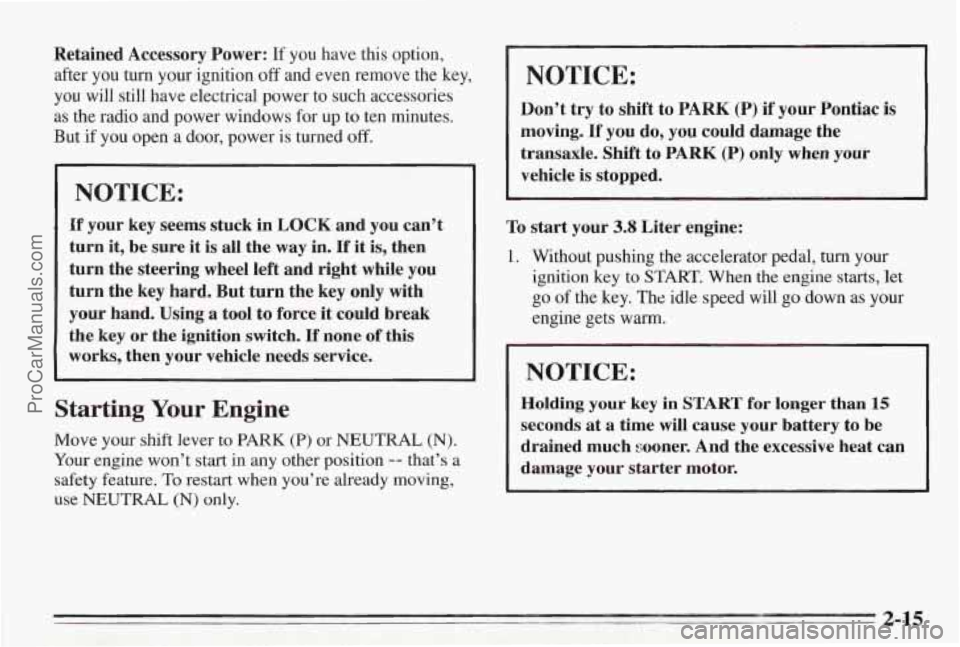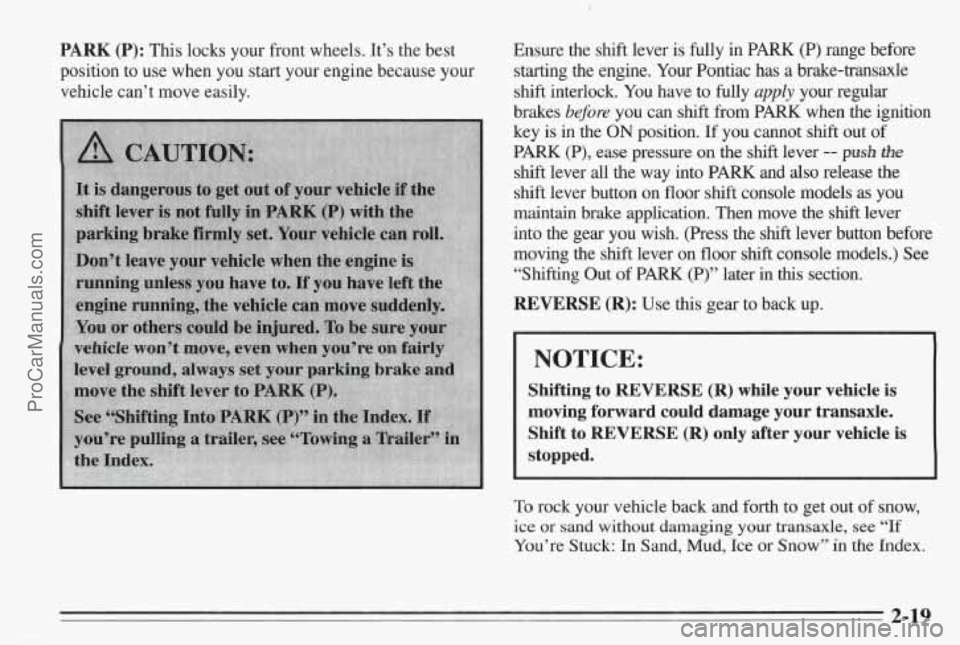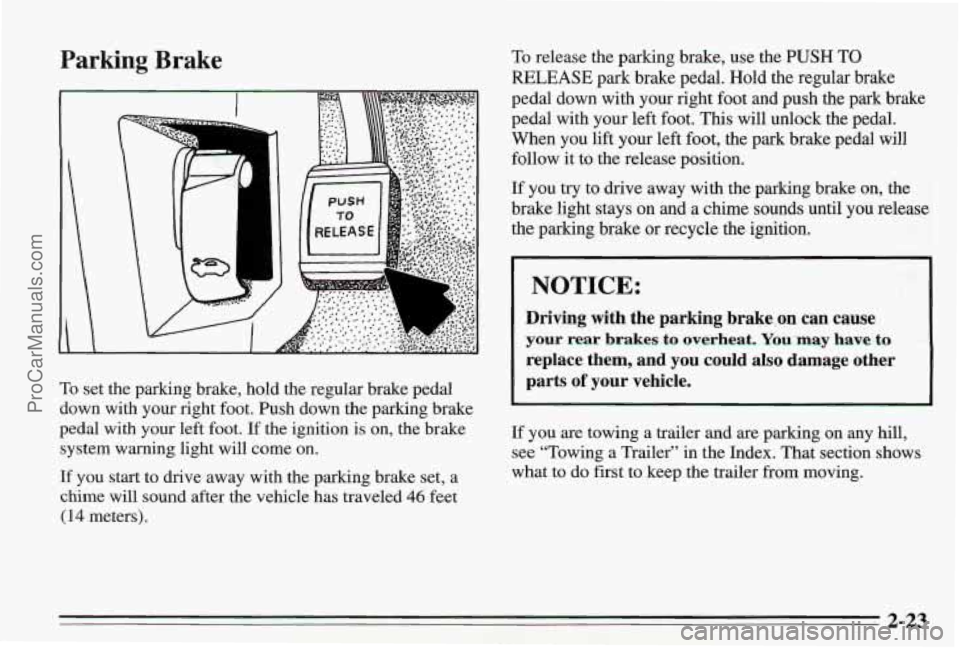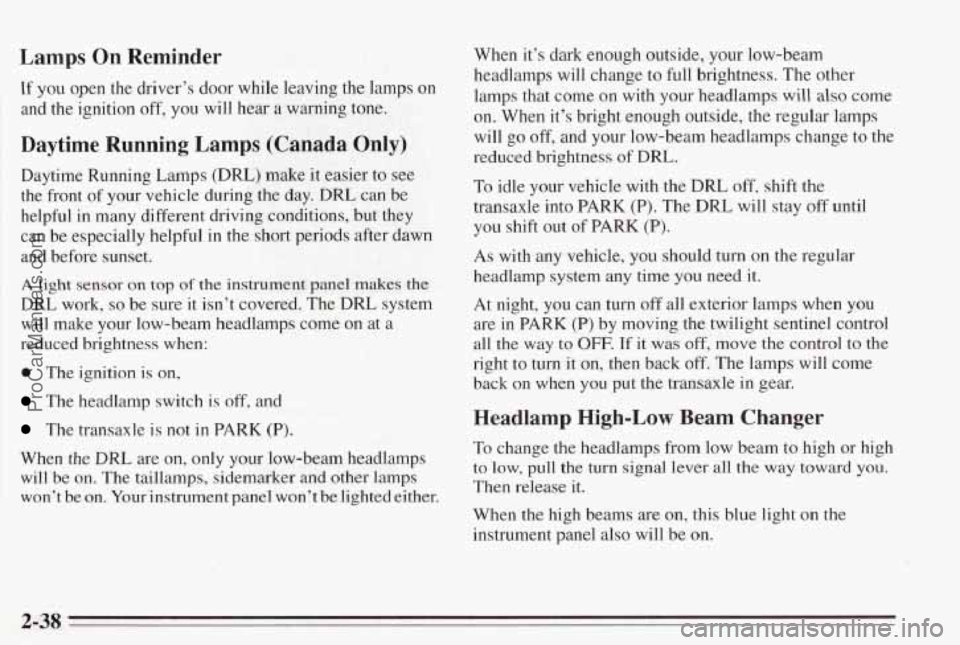Page 64 of 338

Retained Accessory Power: If you have ths option,
after you turn your ignition
off and even remove the key,
you will still have electrical power to such accessories
as the radio and power windows for up to ten minutes.
But if you open
a door, power is turned off.
NOTICE:
If your key seems stuck in LOCK and you can’t
turn it, be sure it is all the way in.
If it is, then
turn the steering wheel left and right while you
turn the key hard. But turn the key only with
your hand. Using a tool to force it could break
the key
or the ignition switch. If none of this
works, then your vehicle needs service.
Starting Your Engine
Move your shift lever to PARK (P) or NEUTRAL (N).
Your engine won’t start in any other position -- that’s a
safety feature.
To restart when you’re already moving,
use
NEUTRAL (N) only.
NOTICE:
Don’t try to shift to PARK (P) if your Pontiac is
moving. If you do, you could damage the
transaxle. Shift to PARK
(P) only when your
vehicle is stopped.
To start your 3.8 Liter engine:
1. Without pushing the accelerator pedal, turn your
ignition key to
START. When the engine starts, let
go of the key. The idle speed will go down as your
engine gets
warm.
NOTICE:
Holding your key in START for longer than 15
seconds at a time will cause your battery to be
drained much sooner.
And the excessive heat can
damage your starter motor.
2-15
ProCarManuals.com
Page 68 of 338

PARK (P): This locks your front wheels. It’s the best
position to use when
you start your engine because your
vehicle can’t move easily. Ensure the shift lever is fully in
PARK (P) range before
starting the engine. Your Pontiac has a brake-transaxle
shift interlock.
You have to fully apply your regular
brakes before you can shift from PARK when the ignition
key is in the
ON position. If you cannot shift out of
PARK (P), ease pressure
on the shift lever -- push t2ze
shift lever all the way into PARK and also release the
shift lever button on floor
shift console models as you
maintain brake application. Then move the shift lever
into the gear you wish. (Press the shift lever button before \
moving the shift lever on floor shift console models.) See
“Shifting Out of PARK (P)” later
in this section.
REVERSE (R): Use this gear to back up.
NOTICE:
Shifting to REVERSE (R) while your vehicle is
moving forward could damage your transaxle.
Shift to REVERSE
(R) only after your vehicle is
stopped.
To rock your vehicle back and forth to get out of snow,
ice or sand without damaging your transaxle, see “If
You’re Stuck: In Sand, Mud, Ice or Snow” in the Index.
2-19
ProCarManuals.com
Page 72 of 338

Parking Brake
A
To set the parking brake, hold the regular brake pedal
down with your right foot. Push down the parking brake
pedal with your left foot.
If the ignition is on, the brake
system warning light will come on.
If you start to drive away with the parking brake set, a
chime
will sound after the vehicle has traveled 46 feet
(14 meters). To
release the parking brake, use the
PUSH TO
RELEASE park brake pedal. Hold the regular brake
pedal down with your right foot and push
the park brake
pedal with your left foot. This will unlock the pedal.
When you lift your left foot, the park brake pedal
will
follow it to the release position.
If you try to drive away with the parking brake on, the
brake light stays on and a chime sounds until you
release
the parking brake or recycle the ignition.
I NOTICE:
Driving with the parking brake,on can cause
your rear brakes to overheat. You may have to
replace them, and you could also damage other
parts
of your vehicle.
If you are towing a trailer and are parking. on any hill,
see “Towing a Trailer” in the Index. That section shows
what to do first to keep the trailer
from moving.
2-23
ProCarManuals.com
Page 74 of 338
0 Move the lever up as far as it will go.
3. Move the ignition key to LOCK.
4. Remove the key and take it with you. If you can
walk away from your vehicle with the ignition key in
your hand, your vehicle
is in PARK (P).
Console Shift Lever
1. Hold the brake pedal down with your right foot and
2. Move the shift lever into PARK (P) position like this:
set the parking brake.
0 Hold
in the button on the lever.
Push the lever all the way toward the front of the
vehicle.
3. Move the ignition key to LOCK.
4. Remove the key and take it with you. If you can
walk away from your vehicle with the ignition key in
your hand, your vehicle is in PARK (P).
2-25
ProCarManuals.com
Page 76 of 338
Shifting Out of PARK (P)
Your Pontiac has a brake-transaxle shift interlock. You
have to fully
apply your regular brake before you can
shift from PARK (P) when the ignition
is in the RUN
pition. See “Automatic Transaxle” in the Index.
If you cannot shift out of PARK (P), ease pressure on
the shift lever--push the shift lever all the way into
PARK (P) as you maintain brake application. Then
move the shift lever into the gear you want. If you ever
hold the brake pedal down but still can’t shift out
of
PARK (P), try this:
1. Turn the key to OFF. Open and close the driver’s
door to turn
off the Retained Accessory Power
feature,
if you have it.
2. Apply and hold the brake until the end of Step 4.
3. Shift to NEUTRAL (N).
4. Start the vehicle and then shift to the drive gear you
want.
5. Have the vehicle fixed as soon as you can.
Parking Over Things That Burn
2-27
ProCarManuals.com
Page 78 of 338
Power Windows
Follow the proper steps to be sure your vehicle won’t
move. See “Shifting Into
PARK (P)” in the Index.
If you are parking on a hill and if you’re pulling a
trailer, also
see “Towing a Trailer” in the Index. Switches on
the driver’s armrest control each
of the
windows when the ignition is on or in retained accessory
power. In addition,
each passenger door has a control
switch for its
own window.
When the driver’s window switch
is held rearward for more
than a half second, the window will lower completely. The
window
can be opened in smaller amounts by pressing the
switch rearward and releasing
it immediately.
TO stop the window while it is lowering, press the
switch again, then release. To raise
the window, hold the
switch
forward.
2-29
ProCarManuals.com
Page 86 of 338
To Get Out of Cruise Control
There are two ways to turn off the cruise control:
Step lightly on the brake pedal; OR
Move the cruise switch to OFF.
Cruise Control with Traction Control
Activated
When the Traction Control System is turned on and
becomes activated by sensors, it will automatically turn
off the cruise control. See “Traction Control System” in
the Index.
To Erase Speed Memory
When you turn off the cruise control or the ignition, or
shift into
PARK (P), your cruise control set speed
memory
is erased.
Lamp Controls
Parking Lamps: Pull the
switch to the first stop to
turn on the:
Parking Lamps
0 Side Marker Lamps
0 Taillamps
0 Instrument Panel Lamps
Headlamps: Pull the switch out all the way to turn on
the headlamps, together with:
0 Parking Lamps
Side Marker Lamps
Taillamps
Instrument Panel Lamps
Push the switch in all the way to turn all the lamps off.
2-37
ProCarManuals.com
Page 87 of 338

Lamps On Reminder
If you open the driver’s door while leaving the lamps on
and the ignition off, you will hear a warning tone.
Daytime Running Lamps (Canada Only)
Daytime Running Lamps (DRL) make it easier to see
the front of your vehicle during the day. DRL can be
helpful in many different driving conditions,
but they
can be especially helpful in the
short periods after dawn
and before sunset.
A light sensor on top of the instrument panel makes the
DRL work, so be sure it isn’t covered. The DRL system
will make your low-beam headlamps come on at a
reduced brightness when:
0 The ignition is on,
The headlamp switch is off, and
The transaxle is not in PARK (P).
When the DRL are on, only your low-beam headlamps
will be
on. The taillamps, sidemarker and other lamps
won’t be on. Your instrument panel won’t be lighted either. When it’s dark
enough outside, your low-beam
headlamps will change to full brightness. The other
lamps that come on with your headlamps will also come
on. When it’s bright enough outside, the regular lamps
will go
off, and your low-beam headlamps change to the
reduced brightness
of DRL.
To idle your vehicle with the DRL off, shift the
transaxle into
PARK (P). The DRL will stay off until
you shift out of PARK
(P).
As with any vehicle, you should turn on the regular
headlamp system
any time you need it.
At night, you can turn off all exterior lamps when
you
are in PARK (P) by moving the twilight sentinel control
all the way to OFF. If it was off, move the control to the
right
to turn it on, then back off. The lamps will come
back
on when you put the transaxle in gear.
Headlamp High-Low Beam Changer
To change the headlamps from low beam to high or high
to low, pull the turn signal lever all the way toward you.
Then release it.
When the high beams are
on, this blue light on the
instrument panel also will
be on.
2-38
ProCarManuals.com